
As a past surgeon for thirty seven years (37), I am a doctor who worked in the trenches in missionary work, in the operating rooms...


President
George W. Yu, M.D.

Vice President
Alan Hyatt
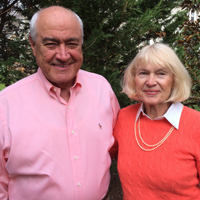
Treasurer
Donald Rembert

(Emeritus Board Members)
Kathy & Kevin Wayson

Executive Administrator
Kim Lorence
Past Board of Trustees and Officers

Joanne Fay Gill passed away on July 5, 2019 after a long road combating Alzheimer’s brain degeneration.
She was one of four founding members of the YuFoundation.org beginning in 2006.
Ironically, now we are on the verge of understanding one of the earlier dysfunctions of Alzheimer brain metabolism with the research done by Dr. Stephen Cunnane and Dr. Richard Veech and Dr. Mary Newport with the generous financial support from Andre Chagnon whose wife was also afflicted with the same problem.

We now have the Beta Hydroxybutyrate ester molecule discovered by Veech of the NIH and already proved that intake of coconut oil, specifically caprylic fatty acid, intake with resultant production of your own beta hydroxybutyrate ketone can offset the early damages of the Alzheimer’s brain from its inability to use glucose sugar as fuel ten years, (10 years) before memory loss confirmed on PET/CAT fused scans & FDG scans first documented by Cunnane of Canada. All inflammation and end products residual may be after the metabolic fuel defect.
We could not save our beloved Joanne but the rest of the world are benefiting already from her generosity and kindness.
We miss her everyday!
George Yu MD, president of the YuFoundation.org 7/15/2019

George W. Yu is a surgeon based out of Annapolis, Maryland and Washington, DC. He has been professor of Urology at the George Washington University Medical Center and partner in Aegis Medical and Research Associates for the last thirty five years. He has dedicated his career to understanding the impact and importance of proper nutrition and the many ways in which the human body responds to different forms of nutrition. Dr. Yu has led the effort to create a foundation which supports groundbreaking research into the links between nutrition and health since 2006.
Founded in 2006, the George W. Yu Foundation for Nutrition and Health focuses on research which holds great promise but may have gone unnoticed by other funding
sources. The Foundation gives preference to efficient and low overheard research, so that grants are used for the actual research funds.
Our foundation made a major decision to also use the website to be a resource center for so many people who are at lost to find the right legitimate avenues to seek nutritional intervention from referring doctors, nutritionists, organizations, even the foods and supplements, books and even recipes etc. can easily find everything from one location linking to other sites. Therefore part of our funding will be dedicated to designing and facilitating easy access to the right organizations and people.
Nutritionally Dense and Caloric Restriction Optimal Nutrition Ketosis Diet (CRONK =1500- 1800 calories / day) Have an Impact on Patients with Widespread Cancer Disease as well as every chronic disease. Even Short Term CRONK and MF (Modified Fasting) Will Help the body Repair Itself.
There are extensive basic science and emerging primate and human research confirming the longevity effects of caloric restriction with optimal nutrition ketosis, CRONK. What is less known is the attenuation effects of CRONK on cancer growth. Basic science research shows that the severity of CRONK, caloric restriction ketosis (20 to 60% of normal calorie intake) is positively correlated with lesser cancer growth. However eradicating all cancer growth using CRONK is more difficult. The bibliography provided in a separate section will have comprehensive references.
CRONK can vary in animal research defined as limiting caloric intake to 20-50%, however for human compliance in "real world scenarios"; nutritional institutes such as the CRONK society, Hippocrates Institute, Kushi Institute, Optimum Health Institute generally use a total of 1500 to 1800 Calories consumed by members per day and are tolerable and acceptable as long as there is sufficient volume, fiber, flavor and nutritional density and ease of digestibility.
Our foundation believes that cycling low calorie and then a period of higher calorie is the most realistic and acceptable way to do it. Modified "Fasting" with soups and juices are helpful for those who do not practice any CRONK.
Our foundation believes that cycling low calorie and then a period of higher calorie is the most realistic and acceptable way to do it. MF, Modified Fasting with soups and juices are helpful for those who do not practice any CRONK.
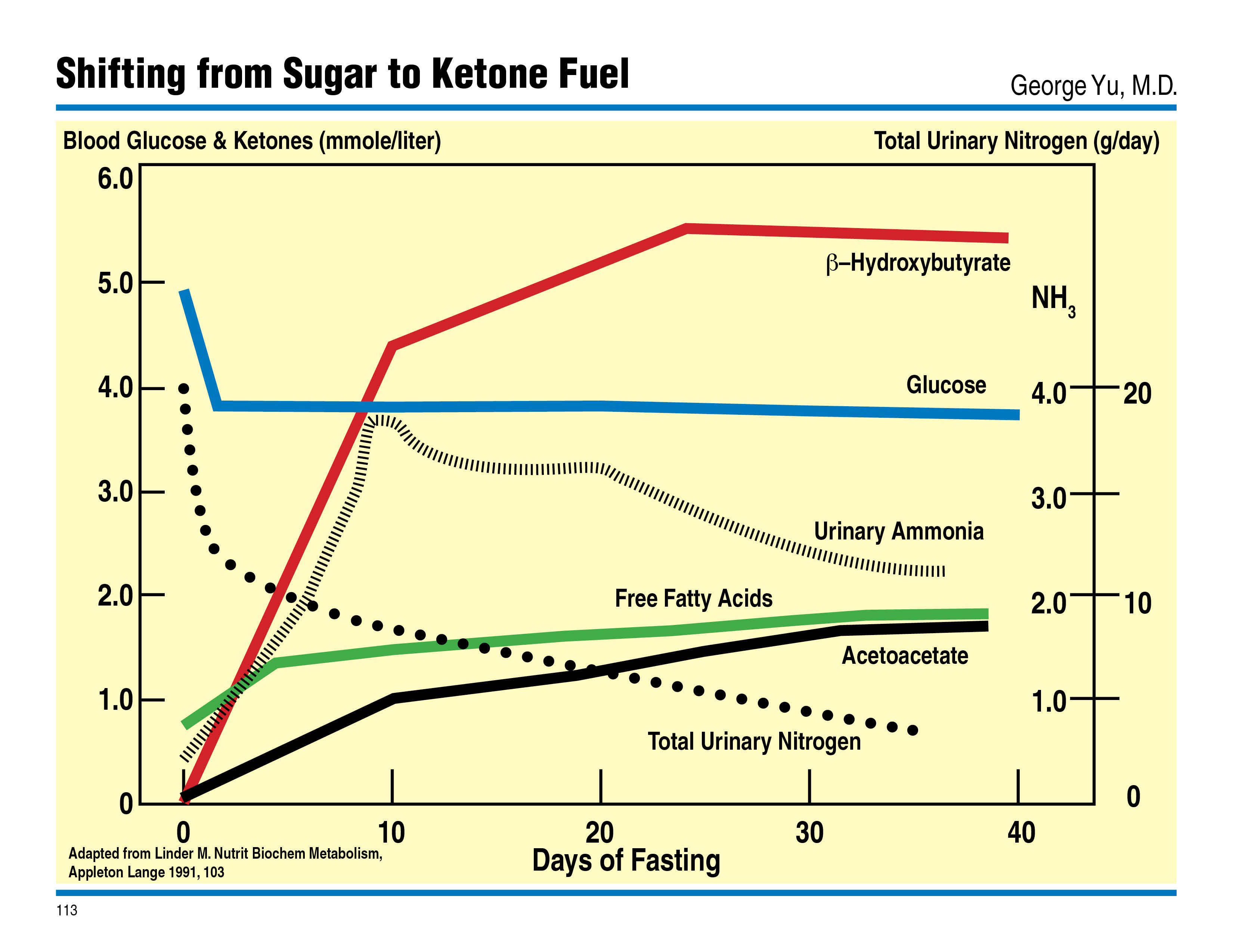
The first human study Biosphere 2 in 1989 isolated eight (8) men and women in a self-contained 4000 square feet sphere for 2 years and all their risk factors for modern diseases decreased such as serum Insulin, glucose, lipids and blood pressures etc. in all eight individuals. This is probably one of the most expensive studies ever done as a preparation for human experience in outer space funded by a visionary billionaire Ed Bass of Texas.
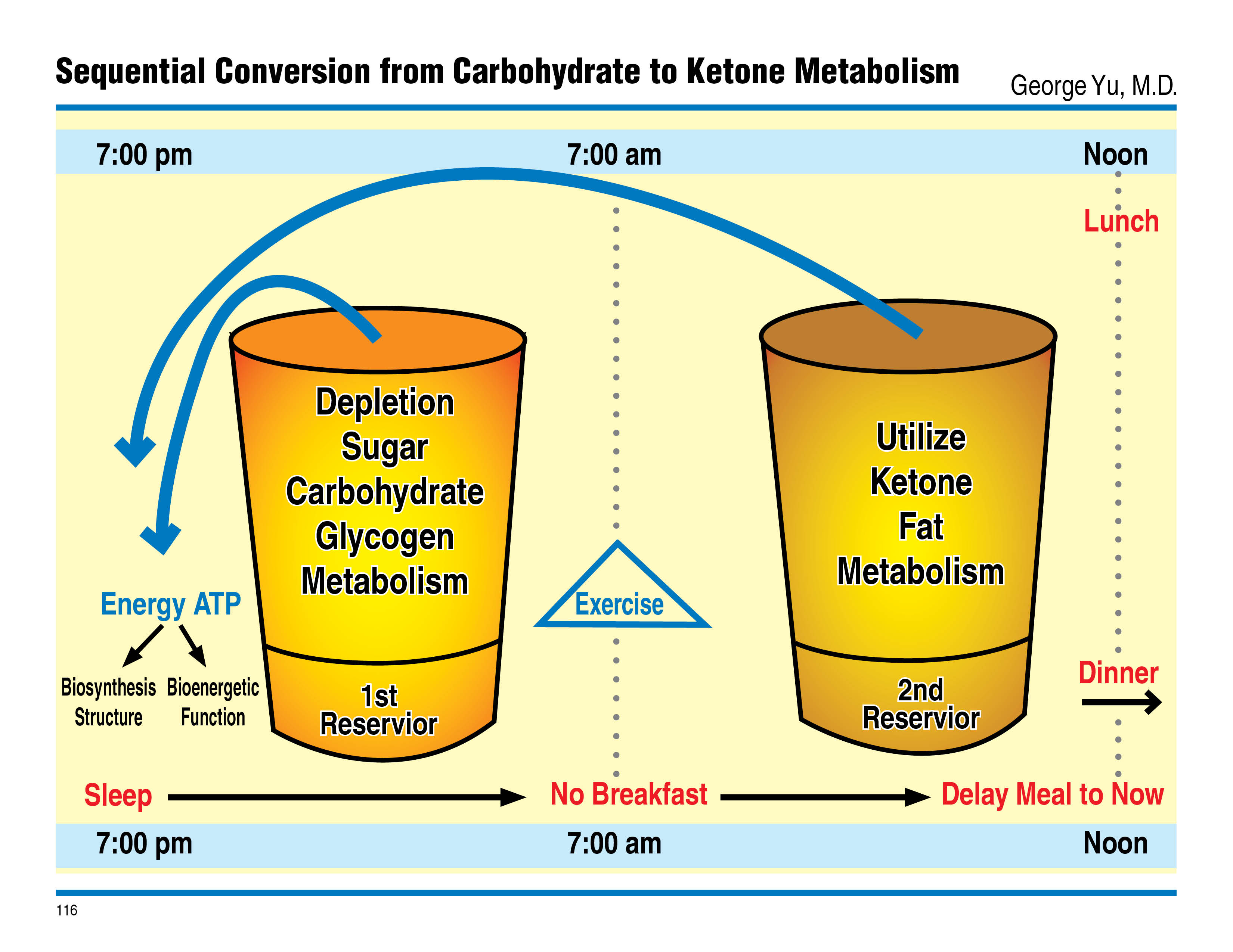
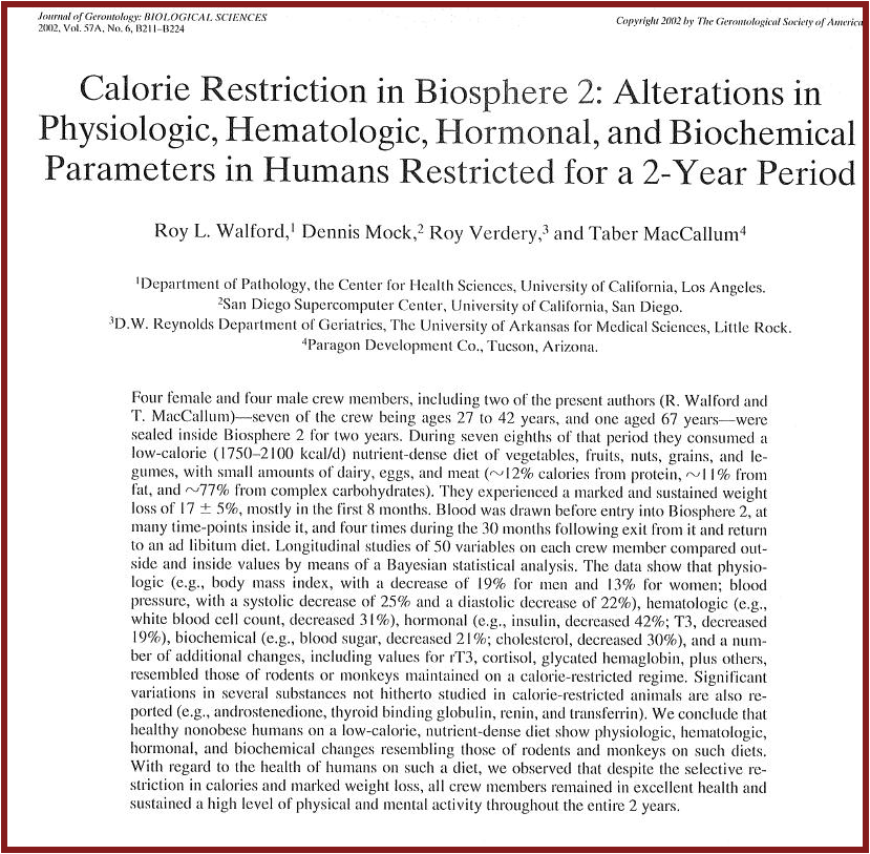
There are institutions worldwide that practice CRONK with members eating a variety of foods from raw vegetable food, cooked vegetable-based foods with minimal animal protein (fish, eggs) and use simple and easily digestible foods with the aids of probiotics and digestive enzymes for efficient food breakdown and digestion. All the practices have a common feature- the total calories consumed per day is around 1500 to 1800 calories. These institutions have an average of 1000 new visitors yearly and the guests stay for 3-5 weeks to accustom themselves to the diet and learn food preparations upon departure. I have been privileged to perform audits on some of the organizations and have witnessed their practices and outcomes.
Dr. George Yu, M.D. - Personal Clinical Experience CRONK effect on Human Cancers Through the Hippocrates and Kushi Institutes and the Caloric Restriction Association
At George Washington University Medical Center and Anne Arundel Medical Center, I have been urological surgical oncologist and reconstructive surgeon for thirty five (35) years and worked as part of the team of medical oncologists, radiation oncologists in designing treatment plans for patients with advanced metastatic cancers. My area of interest has been on the biology of invasive bladder cancers and treatments including surgery, chemotherapy, radiation and CRONK.

A remarkable turn of events for me occurred in 1999 when I volunteered to act as an "auditor" for CAM (Complementary Alternative Medicine) for the "best case analysis" program at National Institute of Health on nutritional interventions in terminal cancer patients with widespread disease. Specifically, working with the Kushi Institute using a "macrobiotic" diet (nutritional dense but caloric limited foods), I audited over 300 cases of people with a variety of primary cancers and usually with metastatic disease. Among cancers studied were people with pancreatic, melanoma, lung, lymphoma, breast cancers all with widespread metastasis who survived and some were cured using nutrition after conventional treatment failures. Dr. Larry Kushi, professor of Epidemiology formally at Columbia University and at present with the Kaiser Institute in California had initially reviewed these original cases as part of a study on nutrition and chronic disease.

After the formal presentation on February 25, 2002 at the NIH with fifteen (15) reviewers who all confirmed positive results from diet alone, I continued to pursue further audits with institutions such as Hippocrates Institute in Florida. Their practice differed in their use of raw vegetable foods (no fruits, no sugar, and no dairy) with similar nutritionally dense but caloric restricted diets and found consistently similar results.

Photo: CRONK diet raw food hypocrites institute
If I did not personally review these medical data charts, see the survivors and failures, consume their foods, I would never have believed or accepted that CRONK nutritional intervention could show such impressive effects on chronic cancerous diseases. People who practice CRONK are content and satisfied using low calorie diets as there is variety. What is consistent after eating CRONK diet regimen for longer than 48 hours is that the hunger sensation diminishes markedly even for people who eat diets with calories up to 3000 per day normally.
Most researchers of "Caloric Restriction Optimal Nutrition Ketosis" CRONK do not believe that it is possible for humans to consume 1500 - 1800 calories per day and feel satisfied because they have rarely experienced it themselves.
Around 2001, the publication by Stephen Spindler’s research team at University of California Riverside showed that 70% of gene expression changed dramatically within 4 weeks of CRONK diets in animal studies suggesting that STCR (Short Term Caloric Restriction) replicated the effects of LTCR (Long Term Caloric Restriction) quickly. The implication is that human and animal genotype responded to external stimulus and adjusted rapidly by modulating gene expressions. This was a critical concept as long-term CRONK has long- term adverse effects and as clinicians if we could "cycle on and off periods" of very strict CRONK and modest increase in the off periods the patient compliance is acceptable and realistic!
Cao, S. X. Dhahbi, J.M., Mote, P.L. & Spindler, S. R. Genomic profiling of short- and long-term caloric restriction effects in the liver of aging mice. (2001) Proc. Natl. Acad. Sci. U.S.A. 98, 10630-10635.
What Did We Learn from monitoring CR cancer patients in 13 years. CRONK + Moderate Ketosis
As noted above, the majority or 2/3 of patients on Caloric Restriction will first respond and later progress, fail and finally die, therefore we need additional adjunctive treatments to improve their survival. How another version of Caloric Restricted Diet with a Ketotic component will fair is yet to be seen but promising as noted above in NIH supported trials.
I believe these cases all had one common feature: these aggressive solid tumor cancers depended on an inefficient metabolism, glycolysis and partly on oxidative phosphorylation, and in layman’s term limiting calories in their diet was a form of "starvation" of cancers.
CRONK diets leads to moderate Ketosis, a metabolic evolutionary adaptation to low calories and we term this CRONK. CRONK ketogenic diet is low calories with additional use of ketone producing foods or supplements. We use Caprylic Acid (Carbon 8 medium chain fatty acids) with the CRONK diets to enhance ketogenic effect without resorting to foods which are difficult to digest.
As James Watson, the Nobel Prize winner defining the structure of DNA emphasized in a lecture at Yale University in 2012 - "Glycolysis is perhaps the Achilles Heel of Cancer Cells."
After observing and practicing CR in our oncological patients for over thirteen (13) years, I am convinced of the importance of Caloric Restriction and or Caloric restricted with a Ketogenic component in retarding aggressive cancer growths. These findings are consistent with the concept that most cancers predominately have a defective metabolism with a predominance of cell glycolysis (Warburg Effect) and a Hexokinase 2 defect of the mitochondria as described by Pedersen and Ko. This may the reason why some of these CR diets had such a profound effect on their cancer growths. Yet only the minority has permanent results and the majority will respond but eventually fail but we do not know why certain individuals respond and others do not.
Ketogenic Diets with Caloric Restriction
The ketogenic diet (a high fat diet) yet low calories used to treat childhood epilepsy are well known to be effective and safe. This old regimen was further developed and popularized at Johns Hopkins by the late Dr. John Freeman and associates. As simple CR diets (without the ketogenic part) often will show "ketosis" as a body adaptation to scares calories intake, the concept of using ketones derived from oils may also lead to a further insult to cancer cells but not to normal body tissue cell metabolism.
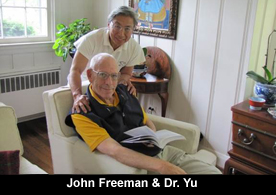
In the nutritional and metabolic approach to cancer arrest, we can use the traditional CR diets as practiced by the above institutions but also the alternative of a high fat ketogenic diet with caloric restriction as two arms of the nutritional approach to cancer eradication. The CR with ketogenic component is especially effective in brain cancers such as Glioblastoma M.
Research and Metabolic Strategy to Arrest Cancer Growth by Decreasing Supply of Glucose, Arresting Full ATP Energy Production, Mitochondrial Disruption, Electron Transfer Dysfunction of Mitochondria etc.
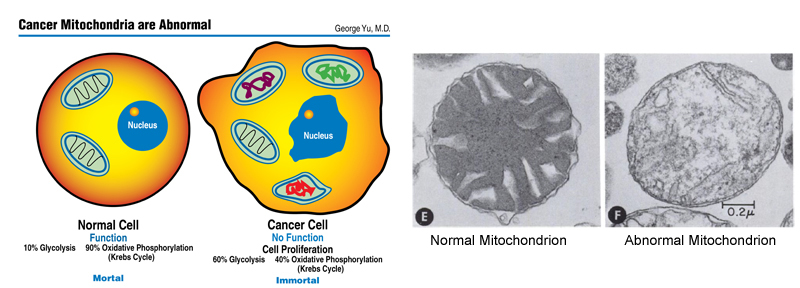
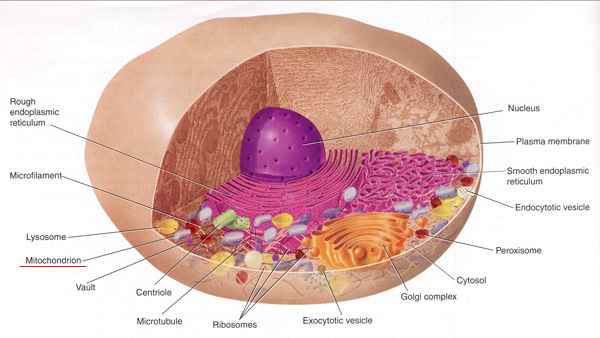
There is accumulated evidence from basic science research showing that most cancer cells use predominately glycolysis (fermentation) energy, but have a defective production of energy from the mitochondria or in other words "unable to utilize oxidative phosphorylation (Krebs Cycle) efficiently".

The basic science research has already been done by many researchers summarized in the recent publication 2012 by Thomas Seyfried Cancer as a Metabolic Disease confirming the "Warburg Effect" for most cancers. This is an excellent summary of all the research and experience worldwide and recommends all to read it.

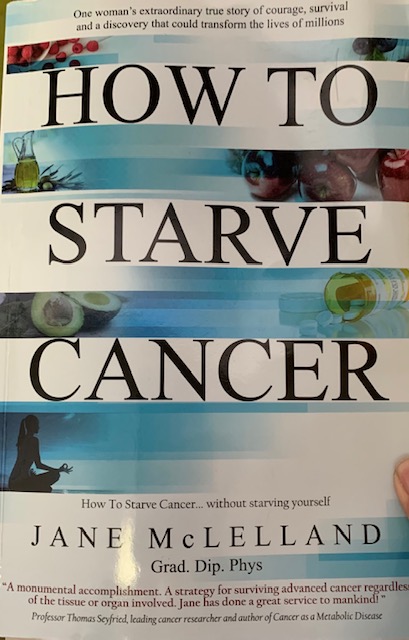
PET/CAT fused scans using FDG 18F-flouro-2deoxyDglucose uptake in cancer cells are an important diagnostic and prognostic tools and the basis of this study is the "glycolytic" nature of cancerous cells.

I have always learnd from Hopkins Medicine magazine but this last issue on recent advances in positron emmission tomography ("PET Projects," Winter 2023) is by far the best issue yet. The content on PET and the future of PET will change medicine worldwide.
The article explained in wonderful detail the landmark discovery of the high metabolic uptake of sugar in 90% of cancers. FDG [which combines PET isotope fluorine-18 and a sugar analog to create fluorodeoxyglucose] has convinced many doctors and patients that so many cancers, such as breast cancer and bladder cancer, need the fuel or substrate of sugar to survive.
The article on the "toxic trade-off" of immunotherapy ["'Toxic Trade-Offs"] shed light on what many people don't understand as they only see the positive side of immunotherapy that many of us doctors explain, while minimizing the side effects.

We medical doctors and researchers are only a part of the truth. Medicine requires people like you, who can select and edit the best way to present technical information to make it understandable in common language to get the point across and reach the tipping point.
As my late mentor Dr. Donald Coffey said to me, "You need the work of all those other groups and professionals and journalists to 'make it tip."
GEORGE YU, MD 1981
“As respiration is responsible for maintaining genomic stability and the differentiated state, respiratory insufficiency will eventually induce the default state of unbridled proliferation.” ~ Thomas N. Seyfried Cancer as a Metabolic Disease page 235
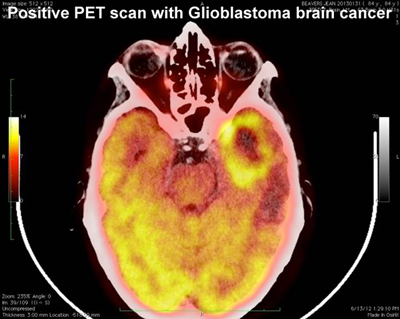
There are many basic researchers and clinicians who are actively pursuing the metabolic approach to cancer disease. The goal is to destroy cancer cells while preserving normal cells.


Research work by Peter Pedersen at Johns Hopkins and Young Ko at University of Maryland, my close associates, show that it may be the cancers derive 60% of energy from glycolysis and up to 40% from an inefficient form of oxidative phosphorylation. In essence cancers may start as a metabolic disease but whether it is from a mitochondrial DNA mutation is unclear. Initiating from the defective metabolism in cancer cells, secondary DNA instability and mutations can take place. The elegant discussion by Drs. Pedersen and Ko below elaborates in detail the rationale of the "Warburg Theory" and their discovery of 3-bromo pyruvate, 3-BrPA. Pedersen and Ko describe 3-BrPA as a potent inhibitor of all ATP production from glycolysis and oxidative phosphorylation in cancerous cells.
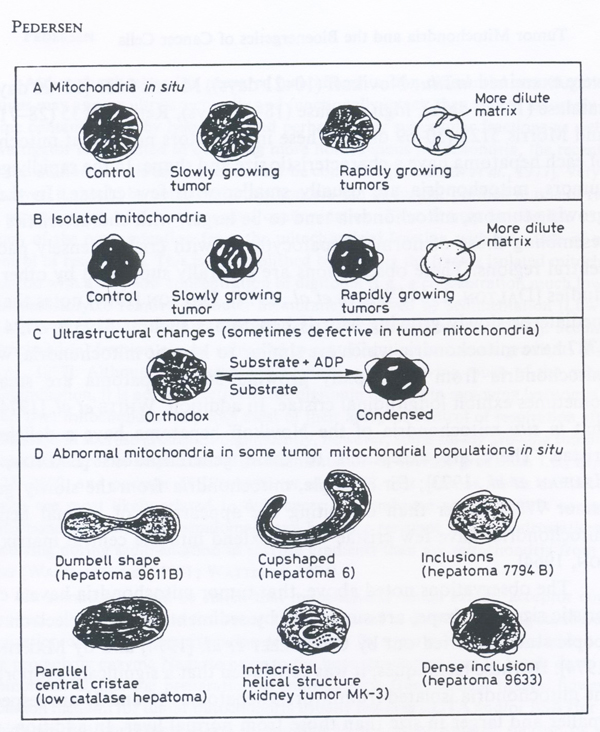
NCI and NIH Mitochondria Interest Group Seminar: Johns Hopkins' Pedersen Addresses Role of Mitochondria in Cancer
https://videocast.nih.gov/summary.asp?live=7542
Pressing Need to Use Caloric Restriction and Adjunctive Agents with Efficacy but Minimum Adverse Effects
National Cancer Institute 60 human cancer cell lines screening with 3 Bromo Pyruvate. May 18 2015 shows promise in human cancer cell deaths using this metabolic agent.
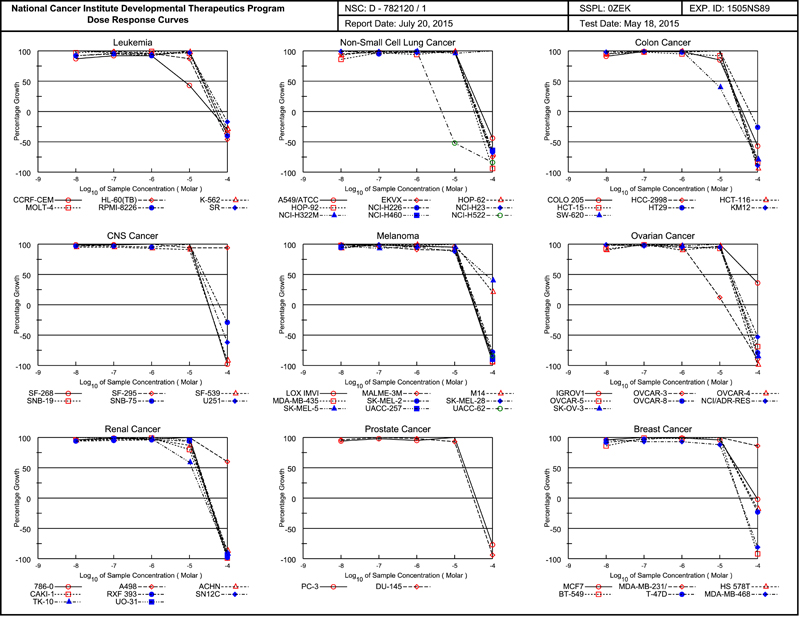
The use of 3 Bromo Pyruvate, 2-Deoxyglucose, Dichloroacetate are among the few of the interesting molecules which may inhibit glycolysis and mitochondrial functions, which may be an important class of chemicals which may enhance the effects of CRONK "Caloric Restriction Optimal Nutrition Ketosis" as a more complete the metabolic approach to cancer eradication.